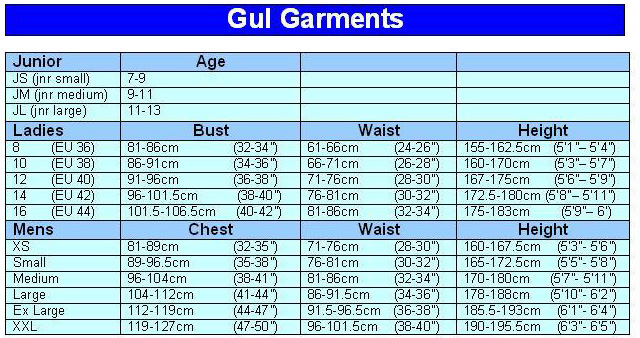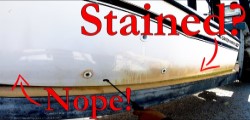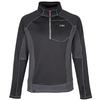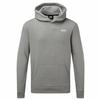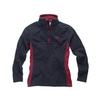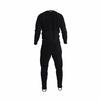 |
|||
|
HOW TO LAYER CLOTHING: THE MID LAYER
FUNCTION
The mid layer is needed in cold weather to provide additional insulation. In other words, its primary function is to keep you warm. A secondary function is moisture wicking (though this is primarily accomplished with your base layer). One thick layer works better for maximum warmth, but the use of multiple thin layers facilitates adjustment of warmth. The mid layer should be more loose-fitting than the inner layer, as this leaves insulating air between the layers.
However, if best possible moisture transfer is desired, too great a gap between any adjacent layers of clothing may reduce the moisture transfer by capillary action from one piece of clothing to another. On the other hand, very loose-fitting layers can allow more removal of moisture (and heat) via air circulation.
MATERIALS
Wool is the traditional mid layer material with several good properties: it has good insulation even when wet, absorbs moisture but does not feel wet even when it holds significant moisture, and transfers moisture. However, wool can often be bulky. Wool also shrinks easily as it dries and is not as easy to care for as fleece.
Fleece made from PETE (Polyethylene) or other synthetics has many of the features of wool, but is lighter. It provides good insulation even when wet, absorbs very little moisture, and dries quickly. Fleece is also machine washable and retains its shape through repeated wash and wear cycles
Down has a very good warmth-to-weight ratio, and can be packed down (squeezed) to take very little room. On the downside, it is expensive, makes a thick garment, dries slowly, loses its insulating properties when wet or compressed, and stops lofting properly after being washed several times.
Synthetic Fiberfill such as polyester fiber is used similarly to down, but does not have as good a warmth-to-weight ratio. However, it is less expensive, provides good insulation even when wet, dries quickly, and absorbs very little moisture. Thinsulate is a brand of very fine fiberfill that provides higher warmth for a given thickness.
Cotton, as with the inner layer, is a cheap alternative, but a reasonable choice only when low insulation and moisture transfer is needed.
STYLES
Mid layers come in a variety of styles. Sweaters, fleece pullovers and vests are all commonly used. On the lower body, fleece or knitted pants are used. Though this layer should be chosen for its functional properties, most wearers will use this layer for casual streetwear, and therefore should choose something they will enjoy wearing.
FIT
Choose a garment that fits somewhat loosely, though it should fit under your top layer without bunching up and causing comfort issues. These garments should not restrict your movement. Natural stretching properties or incorporation of spandex/Lycra materials will provide greater freedom of movement.
SOFT SHELLS
In recent years there have been two developments in fabrics that have added a new dimension to technical clothing. Softshells and Micro Fibres.
Water resistant (Soft Shell) materials block water only partially. On the other hand they are usually more breathable and comfortable, thinner, softer and cheaper than completely waterproof materials. Water-repellent coatings are often used. Before waterproof-breathable shells were invented, the "60/40" (60% cotton, 40% nylon) parka was widely used. Soft shells are not water "proof".
Soft Shells are a sandwich of fabrics that block the wind, trap warm air, breathe and resist water. Not as warm as a fleece garment and not as waterproof as a full-on technical sailing jacket. They do however offer a versatile solution suitable for the majority of weather conditions and are quite simply the most comfortable garments you can hope to wear. Soft shell fabrics come in numerous varieties with many garments offering a combination, such as a wicking layer. In many cases insulation is combined in an attempt to replace several layers with a single highly flexible one.
Micro Fibres are fabrics that are so tightly woven that they resist wind and have a degree of water resistance without using any form of coating. The advantage of this is that they are much more breathable and feel less like an outer layer garment. Micro Fibres are usually combined with some form of insulating material such as fleece or fibre insulation. They make an excellent mid layer that can be used in a much wider range of conditions.
THE 3 LAYERS: A REVIEW
Base Layer: By wearing a thermal underwear base layer, it can physically wick the moisture away from the body (polyester absorbs less than 1% of its own weight in moisture), keeping you dry and warm even after a burst of activity. This first layer or base layer is known as the wicking layer and its main purpose is to keep you dry next to the skin.
Mid Layer: This second layer is the insulating layer. This is the buffer between the warm skin and the cold air outside. It is important that this layer is highly breathable and any moisture can continue its journey into the great outdoors. Traditionally mid-layers have been fleece based garments with or without a windproof shell. More recently Gill has developed mid-layers using ultra compact synthetic insulation. The material is hydrophobic meaning water hating, it will not absorb water and can keep you warm even if wet.
Outer Layer: This is where the real protection against the elements takes place and it must be completely water and windproof. It should include a hood and collar system, protective flaps over the front zip and adjustable inner cuffs. In order to work most efficiently, the fabric should be breathable, thus allowing the moist air that's built up inside the garment to escape.
Size Charts:
Gill Sizing Chart: Men's
|
|
XS
|
S
|
M
|
L
|
XL
|
XXL
|
XXXL
|
|
Average Height (cm)
|
5'2"-5'4"
(158-163) |
5'4"-5'7"
(163-170) |
5'7"-5'10"
(170-178) |
5'10"-6'1"
(178-186) |
6'1"-6'2"
(186-188) |
6'2"-6'3"
(188-191) |
6'2"-6'3"
(188-191) |
|
Chest
(cm) |
34"-36"
(87-92) |
36"-38"
(92-97) |
38"-40"
(97-102) |
41"-43"
(104-109) |
44"-46"
(112-119) |
47"-49"
(120-125) |
50"-52"
(127-132) |
|
Waist
(cm) |
28"
(71) |
29"-30"
(74-76) |
31"-33"
(79-84) |
34"-37"
(87-94) |
38"-40"
(97-102) |
41"-43"
(104-109) |
44"-45"
(112-115) |
|
Inside Leg
(cm) |
29"
(74) |
30"
(76) |
31"
(79) |
32"
(81) |
33"
(84) |
33.5"
(86) |
33.5"
(86) |
Gill Sizing Chart: Women's
| UK USA EURO |
8
4 34 |
10
6 36 |
12
8 38 |
14
10 40 |
16
12 42 |
18
14 44 |
20
16 46 |
| Bust (cm) |
31.5"-32.5"
(80-83) |
33"-34"
(84-87) |
35"-36"
(89-92) |
36.5"-37.5"
(93-96) |
38"-39"
(97-99) |
40"-41"
(102-104) |
42"-43"
(107-109) |
| Waist (cm) |
25"-26"
(63-66) |
26"-27"
(66-69) |
28"-29"
(71-74) |
30"-31"
(76-79) |
32"-33"
(81-84) |
34"-35"
(87-89) |
36"-37"
(92-94) |
| Hips (cm) |
34.5"-35.5"
(88-91) |
36"-37"
(92-94) |
37"-38"
(94-97) |
39"-40"
(99-102) |
41"-42"
(104-107) |
43"-44"
(109-112) |
45"-46"
(114-117) |
